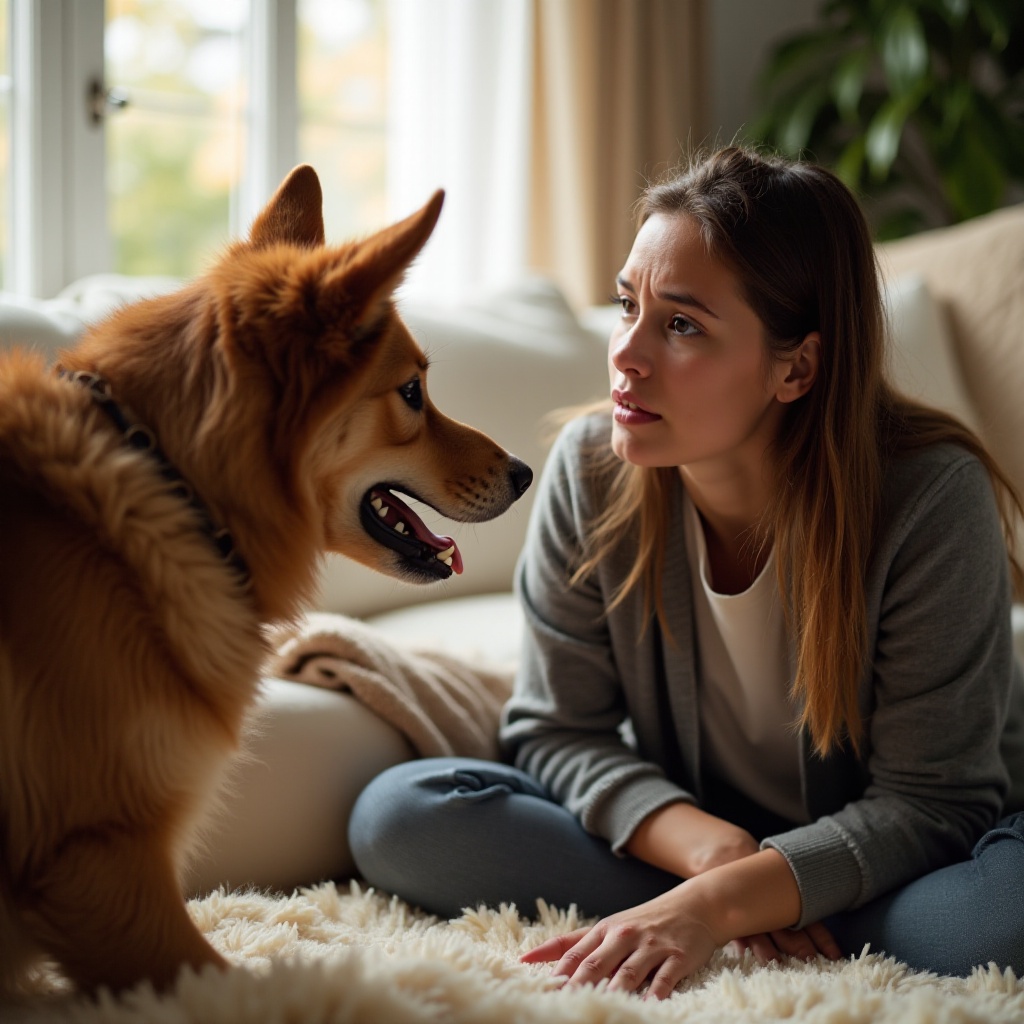Introduction
Dogs communicate in various ways, and whining is often one of them. If your dog has suddenly started whining and acting weird, it can be worrying. Understanding the reasons behind these behaviors is crucial for both your peace of mind and your dog’s well-being. Let’s delve into the common causes and solutions for this issue.

Common Reasons Your Dog is Whining
Whining is a dog’s way of expressing discomfort, fear, or other emotions. Identifying the underlying cause can help you address the problem effectively.
Emotional Causes: Anxiety and Stress
Dogs can experience anxiety and stress due to various factors such as separation from their owners, loud noises like fireworks, or changes in their daily routine. These emotional triggers often lead to whining as a coping mechanism. It’s essential to identify and minimize these stressors to help your dog feel more secure.
Medical Causes: Pain and Illness
Sometimes whining is a symptom of a medical issue. If your dog is in pain or feeling unwell, whining is a natural response. Conditions like arthritis, gastrointestinal problems, or even minor injuries can lead to this behavior. Consulting a veterinarian for a thorough examination can help identify and treat any underlying medical issues.
Environmental Factors: Changes in Surroundings
Dogs are creatures of habit and can become unsettled by changes in their environment. A new home, different furniture arrangement, or the presence of a new pet can cause anxiety. These environmental changes can lead to your dog whining as they adjust to the new circumstances. Keeping consistency in their routine can help them adapt more comfortably.
Identifying and Understanding Weird Behaviors
Besides whining, dogs can exhibit a range of unusual behaviors that might seem off to their owners. Understanding these behaviors is crucial for addressing them effectively.
Aggression or Fearfulness
An aggressive or fearful dog might be reacting to a perceived threat or may be unwell. Fear-driven aggression typically stems from past traumatic experiences or a lack of proper socialization. Identifying the triggers of aggression or fearfulness can help in managing these behaviors.
Unusual Sleeping or Eating Patterns
Changes in sleeping or eating habits can signal underlying health issues. A dog that suddenly sleeps more than usual might be in pain or suffering from an ailment. Conversely, a dog that stops eating might be anxious or have digestive problems. It’s important to monitor these patterns and consult a vet if you notice significant deviations from the norm.
Excessive Barking
Excessive barking can be a sign of various issues, including boredom, anxiety, or territorial behavior. Understanding the context in which your dog barks excessively can help you pinpoint the cause. Addressing the root cause will help in mitigating this behavior effectively.
Effective Behavioral Solutions
Once you identify the cause of your dog’s whining and weird behavior, implementing effective solutions is the next step.
Positive Reinforcement
Using positive reinforcement techniques, such as treats and praise, can encourage your dog to exhibit desirable behaviors. Reward your dog when they remain calm during stressful situations. This reinforces the idea that good things happen when they manage their anxiety or distress appropriately.
Desensitization Techniques
Desensitization involves gradually exposing your dog to the source of their anxiety in a controlled way. For example, if your dog is afraid of loud noises, you can start by playing recordings of these sounds at a low volume while providing treats and comfort. Gradually increase the volume over time to help them build tolerance.
Crate Training
Crate training can provide your dog with a safe space where they feel secure and can retreat to when feeling overwhelmed. Ensure the crate is comfortable and introduce it to your dog with positive reinforcement. Over time, the crate can become a sanctuary where your dog feels safe and relaxed.

Tools and Products That May Help
There are several tools and products available that can assist in managing your dog’s anxiety and weird behaviors.
Calming Aids and Supplements
Supplements containing natural ingredients like chamomile, valerian root, and L-theanine can help reduce anxiety. These can be given as treats or mixed with food to help calm your dog during stressful situations.
Thundershirts and Anxiety Wraps
Thundershirts and similar anxiety wraps apply gentle, constant pressure to your dog’s body, mimicking the sensation of being held. This pressure can have a calming effect and reduce anxiety-related behaviors like whining and pacing.
Interactive Toys
Interactive toys can keep your dog mentally stimulated and distracted from anxiety-inducing situations. Puzzle toys, treat-dispensing balls, and chew toys can provide hours of entertainment and help reduce stress.
When to Seek Professional Help
Sometimes, despite your best efforts, your dog’s behavior might not improve. In such cases, professional help may be necessary.
Consulting a Dog Trainer or Behaviorist
A certified dog trainer or behaviorist can provide personalized guidance and techniques to address your dog’s specific issues. They can observe your dog’s behavior and develop a tailored plan to improve their well-being.
Veterinary Advice
If you suspect a medical issue is causing your dog’s behavior, a visit to the vet is crucial. Vets can conduct thorough examinations and recommend treatments or medications to address any health problems.
Behavioral Therapists
Behavioral therapists specialize in diagnosing and treating behavioral issues in pets. They often work in conjunction with your vet to develop comprehensive treatment plans that address both medical and psychological aspects of your dog’s behavior.

Conclusion
Understanding why your dog is whining and acting weird is the first step toward helping them feel better. By identifying the underlying causes and applying effective solutions, you can improve your dog’s quality of life and strengthen your bond. Always remember, if in doubt, seeking professional help is the best course of action.
Frequently Asked Questions
Is whining always a sign of a problem in dogs?
Not necessarily. While whining can indicate stress, pain, or discomfort, some dogs whine as a form of communication or to seek attention. It’s important to observe the context and other accompanying behaviors.
Can certain breeds be more prone to whining and anxiety?
Yes. Some breeds, like Chihuahuas, Maltese, and Dachshunds, are more prone to anxiety and whining. However, any dog can develop these behaviors based on their individual experiences and environment.
How long should I try home remedies before seeking professional help?
If your dog’s whining and unusual behaviors persist for more than a few weeks despite trying home remedies, it’s advisable to seek professional help. Early intervention can prevent potential worsening of the issue.
